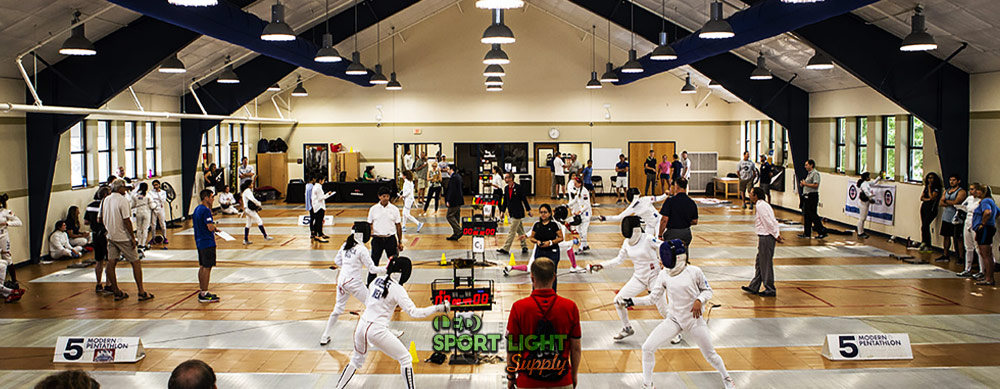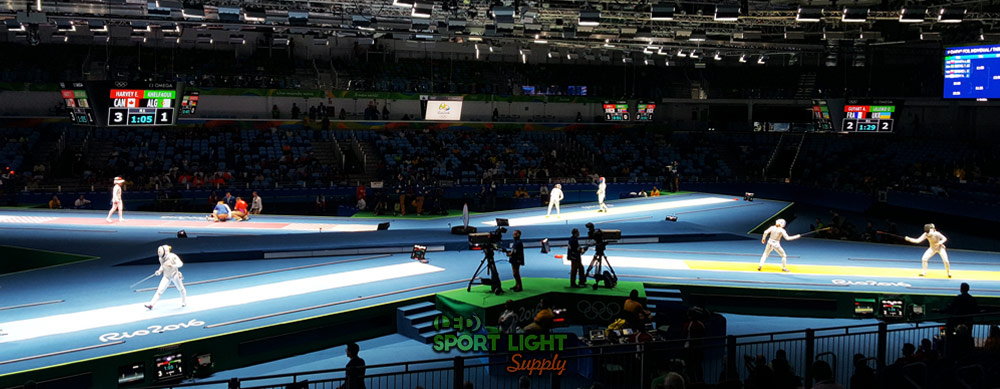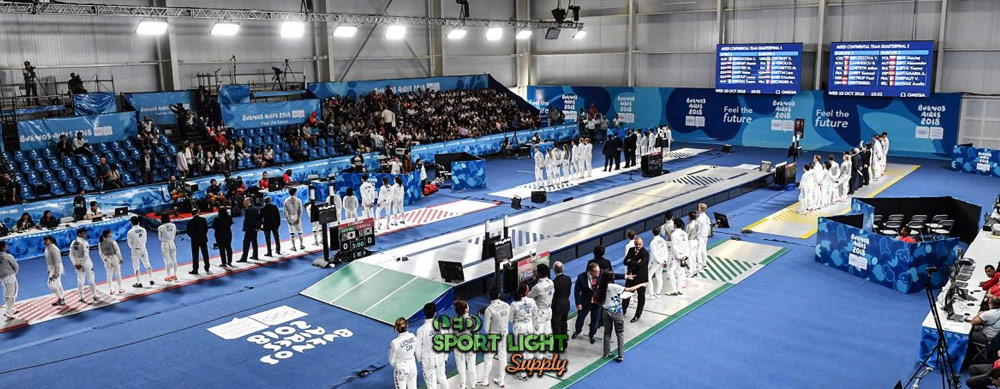Lighting in a fencing hall can significantly enhance both the performance of the fencers and the experience of spectators. With various lighting options available, such as LED, metal halide, mercury vapor, and halogen lamps, determining the best choice is important. Among these, LED lighting stands out as the ideal option due to its superior efficiency, offering up to 85% energy savings while delivering brighter and more uniform illumination for fencing halls of all types. Let’s delve into how to effectively light indoor fencing halls.
Table of Contents
ToggleWhat is the Best Fencing Hall Lighting Design?
Lux Requirements for Fencing Halls and Arenas

The brightness of a fencing hall is a key factor in lighting design, typically measured in lux. Lux represents the amount of light reaching a surface, and a higher lux value indicates a brighter environment. Different types of fencing halls demand varying levels of brightness. For instance, recreational fencing halls may require lower lux levels compared to those used in professional competitions.
For training purposes, a fencing hall typically needs lighting between 250 to 400 lux. This level is sufficient for recreational and practice sessions, providing enough visibility without causing unnecessary strain on the eyes. However, professional fencing competitions, such as the World Fencing Championships and the Olympic Games, demand much higher lux levels, often ranging from 2000 to 3000 lux. This increase in brightness is crucial for capturing the rapid movements of the fencers on 4K broadcasts, ensuring that every action is clearly visible to both live audiences and those watching from home.
The requirements for fencing hall lighting can be summarized as follows:
| Fencing Hall or Arena Type | Lux Requirement |
|---|---|
| Recreational & Training | 250 to 400 lux |
| Regional Fencing Competitions | 600 to 800 lux |
| World Championships & Olympics | > 1000 lux |
As the level of competition intensifies, so does the need for brighter lighting. International events like the Olympic Games necessitate more intense lighting compared to training sessions.
It’s also important to consider both horizontal and vertical lighting in fencing arenas. Horizontal lighting illuminates the fencing strip itself, while vertical lighting focuses on the fencers standing on the strip. High-quality horizontal and vertical lighting ensures that both the athletes and their movements are clearly visible, providing excellent visual quality for international fencing competitions. For a detailed and customized lighting design for your fencing strip, feel free to reach out to us.
Lighting Requirements for Olympic Games Fencing Arenas
Determining the number of lights required for a fencing hall depends on several factors, including the size of the hall and the surrounding environment. Generally, a standard fencing strip may require between 10 to 20 floodlights. However, for larger arenas, particularly those used for major competitions, it’s not uncommon to see more than 100 LED floodlights in use. The exact number and placement of lights depend on factors such as the mounting height and the specific layout of the fencing hall.

Wattage Requirements for Fencing Hall Lighting
The wattage of the lights used in fencing halls varies based on the hall’s size and the type of event it will host. Common wattages include 500W, 1000W, 1500W, and 2000W LED lights. For smaller, recreational halls, a lower wattage may suffice, but for larger venues, especially those hosting national or international competitions, the wattage can increase significantly. In some cases, Olympic fencing halls may require lighting systems exceeding 1500W per light to meet the stringent brightness standards.
Here is an overview of the total LED lighting wattage required for different types of fencing halls:
| Type of Fencing Hall | Total LED Lighting Wattage |
|---|---|
| Training or Recreational | 2000 to 10000W |
| Regional Competitions | 5000 to 20000W |
| National or International Competitions | 25000 to 80000W |
It’s essential to tailor the lighting design to the specific needs of the fencing hall, as no two venues are the same. For a customized lighting solution, including the number and wattage of lights required, please don’t hesitate to contact us.

Lighting Uniformity Requirements for Fencing Halls
Importance of Uniform Lighting
While brightness is a crucial factor, lighting uniformity is equally important in fencing hall design. Lighting uniformity refers to the evenness of light distribution across the entire hall, ensuring that there are no overly bright or dark spots that could hinder visibility. This uniformity is measured on a scale from 0 to 1, with a value closer to 1 indicating more even lighting.
Uniformity is calculated using the formula: minimum lux divided by the average lux of the fencing hall. For example, if the minimum lux value in an area is 400 lux and the average lux is 500 lux, the lighting uniformity would be 0.8. High uniformity is particularly important in professional settings where consistent lighting is needed to avoid any visual distractions or inconsistencies during competition.
The required lighting uniformity varies depending on the level of competition:
| Fencing Hall or Arena Type | Light Uniformity Requirement |
|---|---|
| Recreational & Training | 0.5 to 0.6 |
| Regional Fencing Competitions | 0.6 to 0.7 |
| National or International Competitions | 0.7 to 0.8 |
Higher levels of competition demand greater lighting uniformity to ensure optimal visibility for both athletes and spectators. Achieving the right balance of brightness and uniformity is essential for a successful fencing hall lighting design.
Anti-Glare and Flicker-Free Lighting Design
Minimizing Glare in Fencing Halls
In high-level fencing competitions, where the lux levels can exceed 1000, managing glare becomes crucial. Excessive glare can impair a fencer’s vision and concentration, potentially affecting their performance. To mitigate this, the best fencing hall lighting designs incorporate anti-glare features, ensuring that the lights provide sufficient brightness without causing discomfort.
Flicker-Free Lighting for High-Speed Cameras
Flicker-free lighting is another essential component, particularly for events that are broadcast or recorded. High-speed cameras, often used to capture slow-motion replays, require consistent lighting to avoid flickering, which can degrade video quality. Modern LED lighting systems designed for fencing halls support flicker-free operation at frequencies between 5000 to 8000 Hz, ensuring that every moment is captured with clarity and precision.
Conclusion
Designing the lighting for a fencing hall requires careful consideration of factors such as lux levels, lighting uniformity, and specialized features like anti-glare and flicker-free technology. By selecting the appropriate LED lighting solutions and tailoring the design to the specific needs of the venue, you can ensure optimal visibility for both athletes and spectators, enhancing the overall experience of the sport. Whether for recreational training or high-stakes international competitions, a well-lit fencing hall is essential for safety, performance, and enjoyment.
